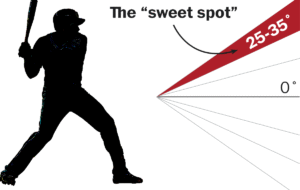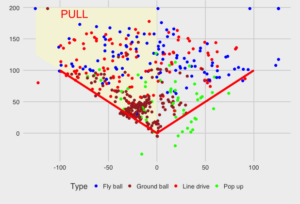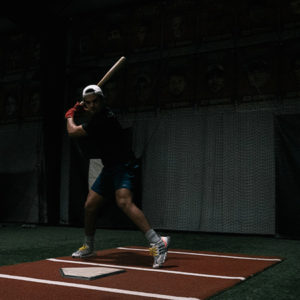In the pursuit of the perfect home run, baseball enthusiasts and professionals alike have long sought to understand the key factors that contribute to a ball's trajectory and ultimate distance. The Statcast model, released in 2017, has revolutionized this area of research by providing an analytical framework that focuses on launch angle and exit velocity as the primary determinants of a batted ball's flight path. Derived from the observed outcomes of similar batted balls during the 2015, 2016, and 2017 seasons, the Statcast model offers valuable insights into the probabilities of home runs for various combinations of launch angle and exit velocity.
However, while the Statcast model has served as a valuable tool in assessing hit probabilities, it has not yet fully accounted for the directional nuances of a ball's flight. For example, a ball hit 385 feet may be a home run when directed straight down the left or right field lines, but it may not clear the center field fence, which averages 403 feet in the Major League Baseball (MLB). To address this limitation, Statcast researchers have been working on an updated model that incorporates spray direction to provide a more accurate estimation of home run probabilities. Though still unpublished, a preview of these results was showcased at the SABR Analytics Conference in March 2018, indicating the potential for even greater insights into the science of hitting home runs in the near future.
Here are some key points that are covered in this article on exit velocity you need to hit a homerun:
- The Statcast model, released in 2017, provides hit probabilities for batted balls based on launch angle and exit velocity, serving as a valuable tool for understanding home run dynamics.
- The model's accuracy could be improved by taking spray direction into account, as it influences home run probabilities depending on the ballpark dimensions and the curvature of the outfield.
- The use of logistic regression models and data analysis in R has led to the development of models that incorporate both distance and spray direction, resulting in a better understanding of home run probabilities.
- The Statcast model has limitations, such as the sharp drop in probabilities at certain points and the potential underestimation of higher probability batted balls, which could be addressed through further refinements.
- Future improvements to the model could include the incorporation of environmental factors, individual hitter characteristics, and advancements in technology and data collection methods.
- Collaboration between researchers, analysts, players, and coaches will be crucial in the ongoing development of the Statcast model, ensuring its continuous evolution and contribution to the understanding of home run dynamics in baseball.
The Statcast Model: Understanding Launch Angle and Exit Velocity
 The introduction of the Statcast model has significantly improved our knowledge of the critical elements that affect a batted ball's trajectory and has provided invaluable insights into the chances of scoring a home run. Launch angle and exit velocity are the two main elements that make up the Statcast formula. Launch angle is the angle at which a ball exits the bat vertically, and exit velocity is the speed at which it does so. The final flight route and distance a batted ball will cover are greatly influenced by these two variables.
The introduction of the Statcast model has significantly improved our knowledge of the critical elements that affect a batted ball's trajectory and has provided invaluable insights into the chances of scoring a home run. Launch angle and exit velocity are the two main elements that make up the Statcast formula. Launch angle is the angle at which a ball exits the bat vertically, and exit velocity is the speed at which it does so. The final flight route and distance a batted ball will cover are greatly influenced by these two variables.
The Statcast model examines the observed results of comparable batted balls within four feet and four degrees of the relevant launch angle and exit velocity using data from the 2015, 2016, and 2017 MLB seasons. This method uses historical data to compare the batted ball in issue to a range of similar balls in order to provide a more precise estimate of hit probabilities. According to the Alan Nathan trajectory calculator, a ball launched at 100 mph and a launch angle of 30 degrees will typically move about 385 feet. Based on the observed outcomes of similar batted balls in the past, the Statcast model gives this specific batted ball a 46% home run chance.
For players, coaches, and analysts alike, the use of the Statcast model has changed the game because it has made it possible for them to better comprehend the elements that go into hitting a home run. Players can improve their hitting techniques to increase their odds of sending a ball soaring over the fence by concentrating on the optimization of launch angle and exit velocity. Similar to this, coaches can use the model's observations to create specialized training plans that focus on the best launch angle and exit velocity combinations for every single player. The Statcast model has consequently evolved into a crucial instrument in the pursuit of the ideal home run.
Direction Matters: The Impact of Spray Direction on Home Run Probabilities
 The Statcast algorithm has shown to be effective in predicting home run probabilities based on launch angle and exit velocity, but one important aspect that has been largely ignored is the batted ball's spray direction. When calculating home run probabilities, it is crucial to take the spray trajectory into account because it affects the distance at which a ball will always be a home run. Here, adding the spray direction to the model can result in more precise forecasts.
The Statcast algorithm has shown to be effective in predicting home run probabilities based on launch angle and exit velocity, but one important aspect that has been largely ignored is the batted ball's spray direction. When calculating home run probabilities, it is crucial to take the spray trajectory into account because it affects the distance at which a ball will always be a home run. Here, adding the spray direction to the model can result in more precise forecasts.
R, a well-known programming language for data analysis, was used in the statistical study to examine the effect of spray direction on home run probabilities. The measured probabilities of success for distance and spray direction were determined after the events were given a status of 1 if they were home runs or 0 if they weren't. The resulting graphs showed a U-shaped curve for the measured probabilities based on spray direction, demonstrating that there is a greater chance of home runs when the ball is hit towards the left or right field lines. This makes sense given that the outfield is curved, and the graph's symmetry is explained by the comparable separations between the left and right field lines from home plate.
It is crucial to make sure that the model assumptions are fulfilled when creating a model that takes distance and spray direction into consideration. These presumptions cover isolated observations, the absence of outliers with a large impact, the logit's linearity, and a low level of multicollinearity among independent variables. Once these presumptions had been verified, a model was developed using logistic regression that took into account both spray direction and distance in forecasting the likelihood of a home run. The GLM function in R was then used to determine the model's parameters.
As shown by the considerably lower AIC value, the final model, which took into account both distance and spray direction, outperformed the distance-only model. Visualizing the relationship between distance and direction using a heat map, the probabilities of hitting a home run followed a U-shaped curve and were symmetric about zero degrees, reflecting the expected relationship between spray direction and home run likelihood. However, some worries with a sudden drop in probability at certain places emerged and call for more research.
In summation, it is important to consider how spray direction affects the likelihood of a home run. Players, coaches, and analysts will be able to comprehend the dynamics of hitting a home run better by making more accurate predictions thanks to the inclusion of this crucial element in the model.
The Future of Home Run Analysis: Updates and Improvements to the Statcast Model
 The Statcast model has been extremely helpful in improving our comprehension of home run probabilities, but there is always space for advancement and creativity. The current shortcomings of the model, such as the sharp decline in probabilities at specific points and the potential underestimation of higher probability batted balls, emphasize the need for additional improvement. Taking care of these problems will enable even more precise predictions and eventually lead to a more thorough knowledge of home run dynamics.
The Statcast model has been extremely helpful in improving our comprehension of home run probabilities, but there is always space for advancement and creativity. The current shortcomings of the model, such as the sharp decline in probabilities at specific points and the potential underestimation of higher probability batted balls, emphasize the need for additional improvement. Taking care of these problems will enable even more precise predictions and eventually lead to a more thorough knowledge of home run dynamics.
Including more variables that influence a batted ball's flight route and distance is one way to enhance the Statcast model. For instance, the trajectory of a ball can be affected by environmental variables like air density, temperature, humidity, and height. These elements could improve the model's ability to forecast home run probabilities in various ballparks and environmental conditions. The distinctive qualities of each hitter, such as their stroke mechanics, strength, and bat speed, should be taken into account as well. The model can be adjusted to better predict the results of each player's at-bats by taking these player-specific factors into consideration.
Furthermore, the future of home run analysis will surely be significantly influenced by developments in technology and data collection techniques. The accuracy and quality of the data used to influence the Statcast model will increase as new technologies are developed, producing predictions that are more accurate and dependable. Machine learning techniques could also be used to find patterns and relationships in the data that conventional statistical methods might miss, possibly revealing new information about the elements that go into hitting successful home runs.
Collaboration between scientists, analysts, athletes, and coaches will be crucial to the Statcast model's continued growth. To make sure the model stays an effective resource for comprehending home run dynamics, they can test new hypotheses, find areas for improvement, and refine the model by combining their collective knowledge and experience. In addition to helping those engaged in professional baseball, the Statcast model's ongoing development will advance knowledge of the physics and biomechanics involved in baseball hitting.
In conclusion, home run analysis has a bright future, with Statcast model updates and improvements positioned to deepen our knowledge of what it takes to hit a home run. The Statcast model will continue to develop and offer priceless insights to players, coaches, and analysts by addressing limitations, incorporating extra variables, utilizing new technologies, and encouraging collaboration.



